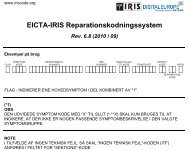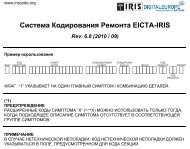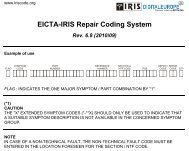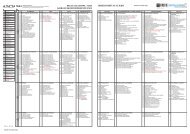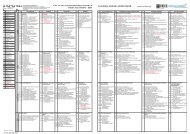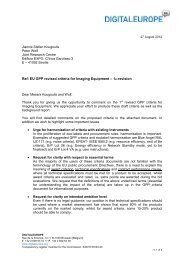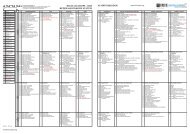EICTA "HD TV" LOGO LICENSE AGREEMENT - DigitalEurope
EICTA "HD TV" LOGO LICENSE AGREEMENT - DigitalEurope
EICTA "HD TV" LOGO LICENSE AGREEMENT - DigitalEurope
You also want an ePaper? Increase the reach of your titles
YUMPU automatically turns print PDFs into web optimized ePapers that Google loves.
<strong>HD</strong>TVrevised – RC001<br />
- multi-channel PCM or an AC-3 according to [15] (implying 11) or DTS according<br />
to [15] (implying [21]) transcoded bitstream in case Enhanced AC-3 and/or HE-<br />
AAC is supported and being received,<br />
whereby:<br />
i. a transcoded bitstream shall have the same channel layout as the originally<br />
received bitstream unless when exceeding the maximum number of channels<br />
supported by the transcoded bitstream format, in which case this maximum<br />
shall be used, and<br />
ii. in case of HE-AAC reception it is permitted, at least until December 31,<br />
2009 4 , to provide a two channel PCM down mix, and<br />
iii. audio output on <strong>HD</strong>MI may be limited to two channel PCM in case the <strong>HD</strong><br />
television receiver provides a minimally 5 channel audio reproduction system<br />
capable of driving at least 5 speakers.<br />
3.3 Specific requirements for <strong>HD</strong> television receivers with display for<br />
video reproduction (Integrated High Definition digital TVs)<br />
The following requirements are applicable to <strong>HD</strong> television receivers with a display for video<br />
reproduction:<br />
15. <strong>HD</strong> television receivers with a display for video reproduction fully comply with the<br />
DIGITALEUROPE “<strong>HD</strong> ready” Minimum Requirements for display devices [1].<br />
16. <strong>HD</strong> television receivers with a display for video reproduction provide for multi-channel<br />
audio out on a consumer electrical or optical digital audio interface (as per requirement<br />
12 above).<br />
3.4 Additional Requirements for <strong>HD</strong> television receivers with recording<br />
capability for “off-air” signals<br />
Under the condition that there are no contractual or legal obligations constraining the recording<br />
of broadcasted content or playback of recorded content, and provided such is allowed by the<br />
content protection status of the received signal, <strong>HD</strong> television receivers with recording capability<br />
for “off-air” signals are able to:<br />
17. - record in <strong>HD</strong> quality any <strong>HD</strong> source (television broadcast) they can receive<br />
and decode, and<br />
- subsequently playback the content in <strong>HD</strong> quality, and<br />
- maintain the aspect ratio of the original signal in the above process, and<br />
- can record accompanying sound (including multi-channel sound) and<br />
- can playback the recorded sound so that an output can be generated<br />
equivalent to the originally received signal.<br />
References<br />
[1] DIGITALEUROPE (http://www.digitaleurope.org) - "<strong>HD</strong> ready" Minimum Requirements /<br />
DIGITALEUROPE Conditions for <strong>HD</strong> Labelling of Display Devices<br />
[2] ETSI EN 300 421 V1.1.2 (1997-08): “Digital Video Broadcasting (DVB); Framing structure, channel<br />
coding and modulation for 11/12 GHz satellite services”<br />
[3] ETSI EN 302 307 V1.1.1 (2005-03): “Digital Video Broadcasting (DVB); Second generation framing<br />
structure, channel coding and modulation systems for Broadcasting, Interactive Services, News<br />
Gathering and other broadband satellite applications”<br />
4 Defined as per the first date the receiver was put on the market<br />
“<strong>HD</strong> TV” <strong>LOGO</strong> <strong>LICENSE</strong> <strong>AGREEMENT</strong> Page 14 of 29



